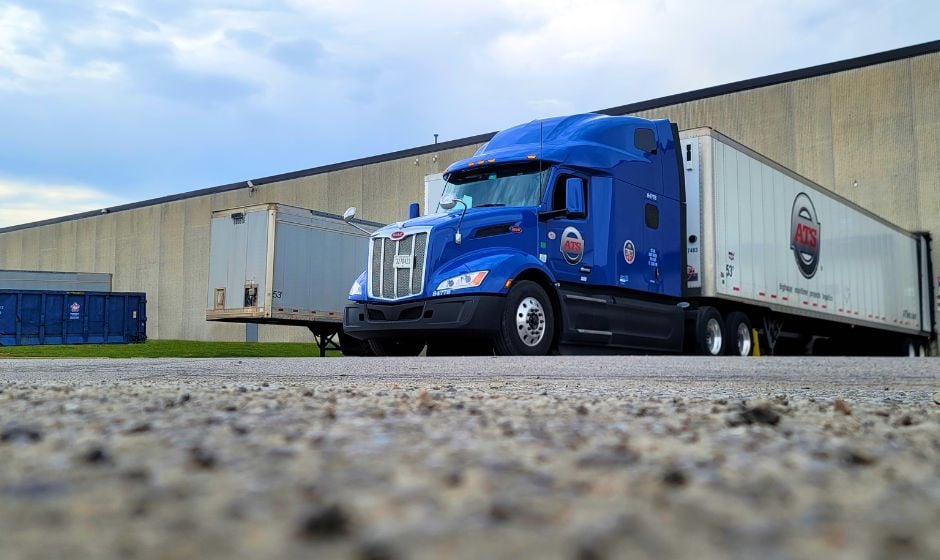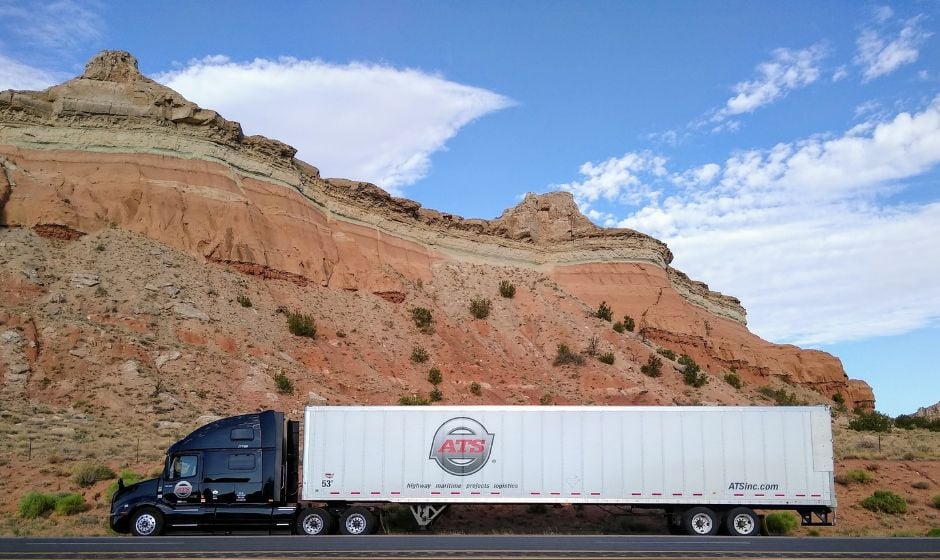
Chocolate vs. vanilla. The Rock vs. Stone Cold. Dry van vs. flatbed shipping. Life is full of tough calls! Among the toughest for shippers? Choosing the right method of moving freight for your shipping needs and your bottom line.
Anderson Trucking Service (ATS) has helped shippers succeed for decades, so we know a thing or two about vans and flatbeds. Dry vans and flatbeds are often compared on the basis of price — but which is more expensive, and why? What factors can lower costs, and what can add dollar signs to your final bill?
We’ll dive into all the elements of dry van vs. flatbed shipping costs below!
- Dry Van Shipping Costs Breakdown
- Flatbed Shipping Costs Breakdown
- Why is flatbed shipping typically more expensive than dry van shipping?
- Dry van or flatbed shipping: Which is right for you (and your budget?)
Dry Van Shipping Costs Breakdown
Freight shipping is an essential piece of your business, so it’s crucial to understand the pricing nuances of every transportation service you use.
Dry van shipping (like other trucking solutions) varies in price. Here’s what you should know about the cost of dry van shipping specifically:
- What is the average price range for shipping dry van freight?
- What factors could increase the cost of dry van shipping?
- What factors could decrease the cost of dry van shipping?
What is the Average Price Range for Shipping Dry Van Freight?
As of February 2024, current OTR dry van rates are averaging $1-3/mile, not including fuel. A good rule of thumb is to factor in fifty cents per mile for fuel costs, so expect your total spend to be about $1.50-3.50/mile.

What Factors Could Increase the Cost of Dry Van Shipping?
Time efficiency & mileage: More time = more $$$, so extra-long hauls can lead to extra costs. As miles go up, the shipper’s cost per mile goes down — yay!
But in turn, the driver’s time on the road goes up, which can result in the total cost of a shipment going up — boo!
And speaking of time, loading times can be a particularly sticky wicket for dry van shipping. Unlike flatbed trailers, dry vans can only load and unload from the rear. This can slow down the process and add time to the load.
Likewise, flexibility is always important. If your shipment has a tight lead time or appointment window, you may pay more for that urgency.
Trailer & shipment requirements: The type of trailer necessary to transport your load can add to your final bill. Refrigerated or food-grade trailers, ventilated trailers, and padded or swing-door trailers will drive your costs up.
Shipment requirements like stop-offs, detentions, and necessitated routes will raise the price, too.
If you need a larger pool of trailers, expect an increased rate. These costs account for trailer availability or lack thereof, relocation miles, and accrued depreciation.
Freight consistency: If shippers can commit to reliable, consistent shipments, they are often rewarded with better rates. The less consistent your shipping needs are, the more expensive it will be to fulfill them via dry van.
Other factors: Elements like cargo value, freight type, headhaul vs. backhaul, market pressure, and seasonality can all increase costs.
For example, during DOT “Blitz Week,” shippers pay more to secure capacity. (Psst: Blitz Week 2024 is May 14-16, for those of you playing along at home!)

What Factors Could Decrease the Cost of Dry Van Shipping?
Time efficiency: Want to decrease your dry van shipping costs? Make like Simone Biles and be flexible!
Flexible lead times and appointment windows make life easier (and more efficient) for your carrier. As a result of these efficiencies, carriers may be able to offer reduced pricing.
Freight consistency: Inconsistency can be expensive. Greater freight consistency allows carriers to dedicate specific drivers to that job.
This can lead to better service as drivers get to know the carrier and vice versa, which increases efficiency, which enables reduced rates . . . you get the idea!
Other factors: Namely, finding the right carrier for your load.
You wouldn’t hire a California-based carrier to haul your local South Carolina load, right? (Who else remembers those old anti-media-piracy TV ads? “You wouldn’t steal a car?” No? Just me?) It would be inefficient and costly. Choosing a localized carrier network makes more sense for all involved.
There we go.
Flatbed Shipping Costs Breakdown
The subtleties of flatbed shipping costs are similar to those of dry van shipping in terms of the basics, like truck availability and time on the load.
But flatbed shipping does have some unique factors to, well, factor into its price structure. Here are the elements you be aware of:
- What is the average price range for flatbed shipping?
- What factors could increase the cost of flatbed shipping?
- What factors could decrease the cost of flatbed shipping?
What is the Average Price Range for Flatbed Shipping?
For February 2024, broad OTR rates are averaging $1.25-$3.50/mile, not including fuel. After factoring in fuel, you can expect to spend around $1.75-$4.00/mile — maybe more, depending on your cargo size. Heavier cargo = higher fuel costs, as the load will be less fuel-efficient.
What Factors Could Increase the Cost of Flatbed Shipping?
Cargo Dimensions & Securement: Heavy, tall, and wide flatbed loads will incur higher costs due to the additional resources necessary to transport them.
Furthermore, if a driver needs a higher-than-average number of straps and tarps (including different sizes) or other securement methods necessary to safely handle the load, those accessorials (and paying for the driver’s time to secure it all) can quickly add up.

Capacity Availability & Timing: Flatbed loads tend to have a higher degree of specificity than dry van shipments, so capacity availability is a larger concern.
Dry vans offer carriers greater flexibility because cargo requiring a standard dry van trailer could also ship in a ventilated trailer, refrigerated trailer, padded trailer, etc.
In the world of flatbed shipping, many loads can only ship on a specific trailer. If that type of trailer isn’t available due to any number of outside factors, the shipper may be out of luck (or have to pay a premium to get the job done).
Timing also plays a part in raising those flatbed shipping rates. Weekend shipments may need to layover until the receiving location reopens on Monday, which bumps up costs.
In an industry where more miles equals better per-mile rates, short-mile shipments can garner higher costs than long hauls.
Your carrier also must have an available driver appropriate for your needs, which could be challenging depending on your location and cargo type.
What Factors Could Decrease the Cost of Flatbed Shipping?
Capacity & Timing: When the capacity availability and timing issues listed above are in your favor, it can result in reduced rates. Aren't random wins nice?
Flexibility with your lead times and appointment windows can help prevent logistical problems. Providing accurate dimensions also helps to prevent confusion and delays.
Distance Loaded & Location: Again, when this aforementioned element is working in your favor, the world is a wonderful place!
The longer the distance loaded and the more advantageous the locations at play, the better the rates you’ll receive.

Why is Flatbed Shipping Typically More Expensive Than Dry Van Shipping?
Flatbed shipping is usually more expensive than dry van shipping for two reasons:
- The drivers: Depending on your type of freight, your shipment may call for a higher class of driver. These drivers take on extra training to become skilled open-deck drivers. Their jobs also call for greater flexibility and fluency in special securement procedures — so shippers pay more for their capability and expertise.
- The trailers: Flatbed trailer capacity isn’t limitless. You want (and need!) the right trailer for your freight. When that trailer isn’t available, your carrier will need to go out of their way (sometimes 200+ miles or more!) to find it and get it to you. They go the extra mile — literally — which means you pay the extra moolah.
It’s our experience at ATS that flatbed rates come in at about a 10% premium compared to dry van rates most of the time. "Most” is the operative word there, though. There have been times in which vans overtook flatbed Cents Per Mile (CPMs), most recently during 2020's COVID-19 lockdowns.
Still, it’s generally safe to assume that, Unprecedented Times aside, flatbed shipping is more expensive than dry van shipping.
Dry Van or Flatbed Shipping: Which is Right For You (and Your Budget)?
So, you've read all this way, but you're still struggling to choose between dry van and flatbed shipping service? Here's a tip: Focus on finding the best overall fit rather than the lowest possible price.
The right carrier partner will know how to achieve price efficiencies for your shipment — so choosing the method that best suits your specific needs is actually a cost-saving tactic in and of itself!
If you're ready to request a quote for your preferred shipping method, contact ATS to learn more about our dry van and flatbed options. Or, continue your selection journey by checking out our free Carrier Selection Checklists! Whether you’re looking for flatbed, freight or heavy haul carriers, we’ve got the resources to help you find your best fit, faster. Happy hunting!




